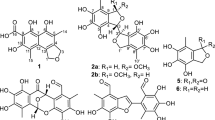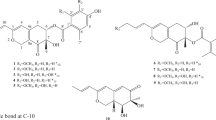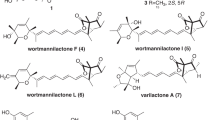Abstract
A new cytotoxic indole-3-ethenamide (1) and two known compounds, 7-(3-methylbut-2-enyl)-1H-indole-3-carbaldehyde (2) and emodin (3) were isolated and identified from the ethyl acetate extract of Aspergillus sclerotiorum PT06-1 in a hypersaline nutrient-rich medium. On the basis of spectroscopic analysis and amino-acid analysis, the new structure of 1 was determined to be (S,E)-3-methyl-2-(N- methylacetamido)-N-(2-(7-(3-methylbut-2-enyl)-1H-indol-3-yl)vinyl)butanamide within 3:1 ratio of rotamers along the acetamido single bond in DMSO-d6 at room temperature. Compound 1 showed moderate cytotoxicity against A-549 cells and weak cytotoxicity against HL-60 cells with the IC50 values of 3.0 and 27 μM, respectively. Compound 2 has been separated as natural product for the first time, and its NMR data were also reported for the first time in this study.
Similar content being viewed by others
Introduction
Natural products produced by halotolerant microorganisms have been considered as an important source of bioactive novel compounds,1, 2, 3, 4 as hypersaline environment might activate some silent genes5 and induce unique biosynthesis pathways.6 Meanwhile, because of many of small peptides possessing a potential or an established use in cancer therapy, these compounds have intrigued us.7 Our previous work revealed two novel cyclic hexapeptides,8 and 11 new aspochracin-type cyclic tripeptides9 from the metabolites of marine-derived halotolerant fungus Aspergillus sclerotiorum PT06-1 in hypersaline nutrient-limited and nutrient-rich media, respectively. Further chemical study led to the identification of a new indole-3-ethenamide (1), along with two known compounds, 7-(3-methylbut-2-enyl)-1H-indole-3-carbaldehyde (2)10 and emodin (3)11 from the ethyl acetate extract of the fermentation broth of A. sclerotiorum PT06-1 in a hypersaline nutrient-rich medium. New compound 1 displayed cytotoxicity against A-549 and HL-60 cell lines with IC50 values of 3.0 and 27 μM, respectively. NMR Data of 2, isolated from the natural source for the first time, was also reported in this study for lack of the corresponding data in literature.
Results
Physico-chemical properties
Compound 1: yellow amorphous powder; [α]D25 –67.5 (c 0.3, CH3OH); HR-ESI-MS m/z 382.2490[M+H]+ (calcd for C23H32N3O2, 382.2495); UV (CH3OH) λmax (log ɛ) nm 202 (4.67), 224 (4.56), 292 (4.43); IR νmax cm−1 (KBr) 3388, 3279, 2969, 2930, 1689, 1633, 1532, 1447, 1324, 1226, 1060, 961, 779 cm−1. 1H and 13C NMR (see Table 1).
Compound 2: yellow amorphous powder; 1H NMR (CDCl3, 600 MHz) δH 12.16 (1H, br s, H-1), 9.94 (1H, s, 3-CHO), 8.29 (1H, d, J=2.2 Hz, H-2), 7.93 (1H, d, J=7.3 Hz, H-4), 7.15 (1H, ‘t’ like, J=7.3, 7.0 Hz, H-5), 7.03 (1H, d, J=7.0 Hz, H-6), 5.41 (1H, tt, J=7.3, 1.5 Hz, H-2′), 3.58 (2H, d, J=7.3 Hz, H-1′), 1.73 (6H, s, H-4′/5′); 13C NMR (CDCl3, 150 MHz) δC 185.0 (d, 3-CHO), 138.3 (d, C-2), 135.8 (s, C-7a), 132.6 (s, C-3′), 125.6 (s, C-3a), 124.2 (s, C-7), 122.6 (d, C-5), 122.4 (d, C-6), 121.8 (d, C-2′), 118.6 (s, C-3), 118.5 (d, C-4), 28.9 (t, C-1′), 25.5 (q, C-4′), 17.8 (q, C-5′).
Cytotoxicity
The cytotoxicity of 1 was evaluated against A-549 cell line by the SRB method and HL-60 cell line by the MTT method, with the IC50 values of 3.0 μM and 27 μM, respectively.
Structure determination
Compound 1, obtained as single peak during HPLC separation, was isolated as yellow amorphous powder. The molecular formula of 1 was determined to be C23H31N3O2 from the positive HRESIMS peak at m/z 382.2490 [M+H]+ (cacld for C23H32N3O2, 382.2495). UV absorptions at λmax at 202, 224 and 292 nm indicated an aromatic chromophore or extended conjugation. Broad IR absorptions at 3279 and 1633 cm−1 indicated the presence of amide NH and an amide carbonyl, respectively. The NMR data for 1, however, were much more complex than expected. Interestingly, two sets of NMR signals appeared, with the ratio of 3:1 in DMSO-d6 at room temperature. The 1H and 13C NMR spectra (Supplementary Figures S2 and S3) of the major one (1a) displayed characteristic signals for one indole and one isopentenyl moiety. 1H-1H COSY (Supplementary Figure S6) of HN-1/H-2, H-4/H-5/H-6 and H-8/H-9/HN-10, and the key HMBC (Supplementary Figure S7) correlations from H-1′ (δH 3.52) to C-6 (δC 120.7), C-7 (δC 125.0), C-7a (δC 135.7) and C-3′ (δC 132.3), from H-8 (δH 6.44) to C-2 (δC 123.5) and C-3a (δC 125.0) and from H-4′/H-5′ (δH 1.71) to C-2′ (δC 122.3), and C-3′ further supported that a 7-isopentenylindol-3-(2-aminoethenyl) indole moiety was presented in 1a. The large coupling constant, J8,9 (15.1 Hz) indicated E- configuration of the C8=C9 double bond. In addition, 1H-1H COSY of H-12/H-16/H-17 and H-16/H-18 and HMBC connections from H-12 (δH 4.71) to C-11 (δC 167.4) and C-14 (δC 170.9), from H-19 (δH 3.00) to C-12 (δC 60.9) and C-14, and from H-15 (δH 2.06) to C-14 suggested that a N-acetyl-N-methylvaline unit was also presented in 1a (Figure 1). The key HMBC correlation between HN-10 (δH 10.16) and C-11 revealed that the two moieties were further connected into amide. The minor one (1b) shared the same 2D NMR correlations as those of 1a (Supplementary Figure S5–S8). The obvious differences of 1H and 13C NMR between 1a and 1b main were δCH−12, δCH−19 and δH−15 (Table 1), indicating that 1a and 1b was a pair of conformers resulted from the rotation of acetamido single bond, N13C14. The synperiplanar (sp)/antiperiplanar (ap) interconversion of amide rotamers is sufficiently slow on the NMR spectroscopy that display steric and electronic differences.12 The sp and ap configurations of 1a and 1b, respectively, were deduced from the upfield shift for CH-12 in 1a and CH3-19 in 1b, respectively, due to the shielding effect of 14-CO.13 This deduction was further supported by the NOE effects between H-15 and H-19 in 1a, and between H-15 and H-12 in 1b, respectively, in NOESY experiment (Figure 1 and Supplementary Figure S8). The absolute configuration of N-methylvaline unit was determined as L- by Marfey's method.14 The FDAA derivatives of the acid hydrolysates of 1 gave the same retention time as that prepared from authentic N-Me-L-Val in HPLC analysis (Supplementary Figure S1). Thus, structure of 1 was determined to be (S,E)-3-methyl-2-(N-methylacetamido)-N-(2-(7-(3-methylbut-2-enyl)-1H-indol-3-yl)vinyl)butanamide. To the best of our knowledge, dipeptides possessing dehydrotryptamine functionality were scarcely found in nature.
Biosynthesis
Compound 1 was probably biosynthesized mainly via a mixed amino-acid mevalonic-acid pathway. Tryptophan and valine condensed to a dipeptide that then underwent decarboxylation, dehydrogenation and isoprenylation with mevalonic acid to form an intermediate 1c. The intermediate 1c was postulated to further undergo N-acylation and N-methylation to produce the bioactive 1. Compound 2 might be resulted from the degradation of intermediate 1c (Scheme 1).
methods
General experimental procedures
Optical rotations were obtained on a JASCO P-1020 digital polarimeter (JASCO Corporation, Tokyo, Japan). IR spectra were recorded using a Bruker model. UV spectra were recorded on Beckman DU 640 spectrophotometer (Beckman, Brea, CA, USA). 1H, 13C NMR and DEPT spectra and 2D-NMR were recorded on a JEOL JNM-ECP 600 spectrometer (JEOL Ltd., Tokyo, Japan) using TMS as internal standard and chemical shifts were recorded as δ values. ESI-MS was measured on a Q-TOF Ultima Global GAA076 LC mass spectrometer (Waters, Milford, MA, USA). Semipreparative HPLC was performed using an ODS column (YMC-pack ODS-A, 10 × 250 mm, 5 μM, 4 ml min−1).
Strain
The halotolerant fungus A. sclerotiorum PT06-1 was isolated from sediments collected in the Putian salt field, Fujian Province of China. It was identified according to its morphological characteristics and 18S rRNA sequences.8, 9 The voucher specimen is deposited in our laboratory at −80 °C. The working strain was prepared on potato dextrose agar slants containing 10% NaCl and stored at 4 °C.
Fermentation
The fungus A. sclerotiorum PT06-1 was incubated on a rotary shaker (160 rpm) at 28 °C for 16 days in 500 ml × 200 conical flasks containing the liquid medium (150 ml per flask) composed of glucose (1.5 g), maltose (3 g), mannitol (3 g), yeast extract (0.45 g), monosodium glutamate (1.5 g), corn steep liquor (0.15 g), NaCl (12 g), MgSO4 (0.75 g), KH2PO4 (0.75 g), NH4Cl (0.75 g) and KCl (0.75 g), adjusting its pH to 7.0.
Extraction and isolation
The fermented whole broth (30 l) was filtered through cheesecloth to separate into supernatant and mycelia. The former was concentrated in vacuo to about a quarter of original volume and then extracted three times with the same volume of ethyl acetate to give an ethyl acetate solution, while the latter was extracted three times with 5 l acetone-H2O (4:1). The acetone solution was evaporated under reduced pressure to afford an aqueous solution. The aqueous solution was extracted three times with the same volume of ethyl acetate to give another ethyl acetate solution. Both the ethyl acetate solutions were combined and concentrated in vacuo to give a crude extract (50.2 g). The crude extract was then subjected to vacuum liquid chromatography using step gradient elution with CHCl3–MeOH (100:0, 100:1, 50:1, 30:1, 20:1, 10:1) to give six fractions (fractions 16) based on TLC properties. Fraction 3 (7 g) eluted with CHCl3–MeOH (50:1) was further applied to ODS column chromatography using step gradient elution with H2O-MeOH into five subfractions (fractions 3.13.5). The subfraction 3.4 (480 mg), eluted with MeOH–H2O (4:1), was then separated by semipreparative HPLC (80% MeOH-H2O) to yield 3 (10 mg, tR 5 min), 2 (3 mg, tR 10 min) and 1 (8 mg, tR 16 min).
Absolute configuration of amino acid in 1 by Marfey's method
Compound 1 (1 mg) was hydrolyzed in HCl (6 M; 1 ml) for 20 h at 110 °C.14 The solution was then evaporated to dryness and redissolved in H2O (250 μl). A 100 μl of 1% (w/v) solution of L-FDAA (1-fluoro-2,4-dinitrophenyl-5-L- alanine amide) in acetone was then added to an aliquot (50 μl) of the acid hydrolysate solution. After addition of NaHCO3 solution (1M; 20 μl), the mixture was incubated at 45 °C for 1 h. The reaction was quenched by addition of HCl (2 M, 10 μl). Analyses of the FDAA derivatized hydrolysate of 1 and standard FDAA-derivatized N-Me-Val were carried out by HPLC (solvents: A water+0.2%TFA, B MeCN; linear gradient: 0 min 25% B, 40 min 60% B, 45 min 100% B; 30 °C 1 ml min−1; UV detection at λ 340 nm). Retention times for the N-Me-valine (N-Me-Val) derivatives of hydrolysates of 1 and the authentic N-Me-L-Val and N-Me-D-Val were tR 28.3 min, 28.4 min and 30.8 min, respectively. Co-injection of the authentic sample with the hydrolysate confirmed that the N-Me-Val residue was L-configuration (Supplementary Figure S1).
Biological assay
Compounds 1 was evaluated for cytotoxic effects on HL-60 cell line using the MTT method15 and on A-549 cell line using the SRB method.16 In the MTT assay, cell lines were grown in RPMI-1640 supplemented with 10% FBS under a humidified atmosphere of 5% CO2 and 95% air at 37°C. Cell suspensions, 200 μl, at a density of 5 × 104 cell per ml were plated in 96-well microtiter plates and incubated for 24 h. Thereafter, 2 μl of the test solutions (in MeOH) were added to each well and further incubated for 72 h. The MTT solution (20 μl, 5 mg ml−1 in IPMI-1640 medium) was then added to each well and incubated for 4 h. Old medium containing MTT (150 μl) was then gently replaced by DMSO and pipetted to dissolve any formazan crystals formed. Absorbance was then determined on a Spectra Max Plus plate reader (Molecular Devices, Sunnyvale, CA, USA) at 540 nm. In the SRB assay, 200 μl of the cell suspensions were plated in 96-well plates at a density of 2 × 105 cell per ml. Thereafter, 2 μl of the test solutions (in MeOH) was added to each well and the culture was further incubated for 24 h. The cells were fixed with 12% trichloroacetic acid and the cell layer stained with 0.4% SRB. The absorbance of the SRB solution was measured at 515 nm. The IC50 values were obtained using the Bliss method.

The postulated biosynthesis of 1 and 2.
References
Lu, Z. Y. et al. Citrinin dimers from the halotolerant fungus Penicillium citrinum B-57. J. Nat. Prod. 71, 543–546 (2008).
Wang, W. L. et al. Two new cytotoxic quinone type compounds from the halotolerant fungus Aspergillus variecolor. J. Antibiot. 60, 603–607 (2007).
Wang, W. L. et al. Isoechinulin-type alkaloids, variecolorin A-L, from halotolerant Aspergillus variecolor. J. Nat. Prod. 70, 1558–1564 (2007).
Wang, W. L. et al. Three novel, structurally unique spirocyclic alkaloids from the halotolerant B-17 fungus strain of Aspergillus variecolor. Chem. Biodiv. 4, 2913–2919 (2007).
Koch, A.L. Genetic response of microbes to extreme challenges. J. Theor. Biol. 160, 1–21 (1993).
Méjanelle, L., Lòpez, J. F., Gunde-Cimerman, N. & Grimalt, J. O. Ergosterol biosynthesis in novel melanized fungi from hypersaline environments. J. Lipid. Res. 42, 352–358 (2001).
Janin, Y. L. Peptides with anticancer use or potential. Amino Acids 25, 1–40 (2003).
Zheng, J. K. et al. Novel cyclic hexapeptides from marine-derived fungus, Aspergillus sclerotiorum PT06-1. Org. Lett. 11, 5262–5265 (2009).
Zheng, J. K. et al. Cyclic tripeptides from the halotolerant fungus Aspergillus sclerotiorum PT06-1. J. Nat. Prod. 73, 1133–1137 (2010).
Liu, K., Wood, H. B. & Jones, A. B. Total synthesis of asterriquinone B-1. Tetrahedron Lett. 40, 5119–5122 (1999).
Cohen, P. A. & Towers, G. H. N. Anthraquinones and Phenanthroperylenequinones from Nephroma Laevigatum. J. Nat. Prod. 58, 520–526 (1995).
Dugave, C. & Demange, L. CisTrans isomerization of organic molecules and biomolecules: implications and applications. Chem. Rev. 103, 2475–2532 (2003).
Toske, S. G., Jensen, P. R., Kauffman, C. A. & Fenical, W. Aspergillamides A and B: modified cytotoxic tripeptides produced by a marine fungus of the genus Aspergillus. Tetrahedron 54, 13459–13466 (1998).
Marfey, P. Determination of D-amino acids. II. Use of a bifunctional reagent, 1,5-difluoro-2,4dinitrobenzene. Carlsberg Res. Commun. 49, 591–596 (1984).
Mosmann, T. Rapid colorimetric assay for cellular growth and survival: application to proliferation and cytotoxicity assays. J. Immunol. Meth. 65, 55–63 (1983).
Skehan, P. et al. New colorimetric cytotoxicity assay for anticancer drug screening. J. Nat. Cancer Inst. 82, 1107–1112 (1990).
Acknowledgements
This work was supported by grants from the Major Program for Technique Development Research of New Drugs in China (No. 2009ZX09103-046), from Special Fund for Marine Scientific Research in the Public Interest of China (No. 2010418022-3), from National Basic Research Program of China (No. 2010CB833800), from the National Natural Science Foundation of China (No. 30470196 & 30670219), and from PCSIRT (No. IRT0944). The cytotoxicity assay was performed at the Shanghai Institute of Materia Medica, Chinese Academy of Sciences.
Author information
Authors and Affiliations
Corresponding author
Additional information
Supplementary Information accompanies the paper on The Journal of Antibiotics website
Supplementary information
Rights and permissions
About this article
Cite this article
Wang, H., Zheng, JK., Qu, HJ. et al. A new cytotoxic indole-3-ethenamide from the halotolerant fungus Aspergillus sclerotiorum PT06-1. J Antibiot 64, 679–681 (2011). https://doi.org/10.1038/ja.2011.63
Received:
Revised:
Accepted:
Published:
Issue Date:
DOI: https://doi.org/10.1038/ja.2011.63
Keywords
This article is cited by
-
Exploring Potential of Aspergillus sclerotiorum: Secondary Metabolites and Biotechnological Relevance
Mycological Progress (2023)
-
Fungi from the extremes of life: an untapped treasure for bioactive compounds
Applied Microbiology and Biotechnology (2020)
-
Fungi in salterns
Journal of Microbiology (2019)
-
Screening and identification of Aspergillus activity against Xanthomonas oryzae pv. oryzae and analysis of antimicrobial components
Journal of Microbiology (2019)
-
New rubrolides from the marine-derived fungus Aspergillus terreus OUCMDZ-1925
The Journal of Antibiotics (2014)




